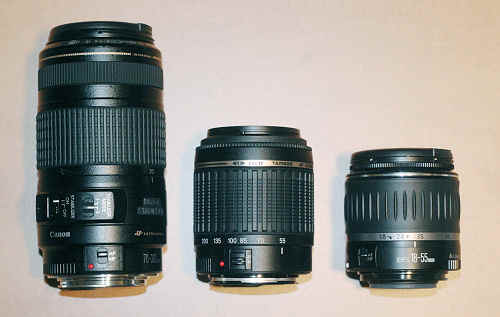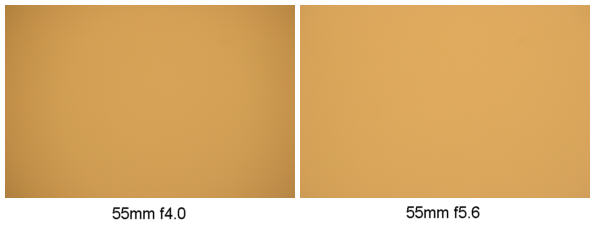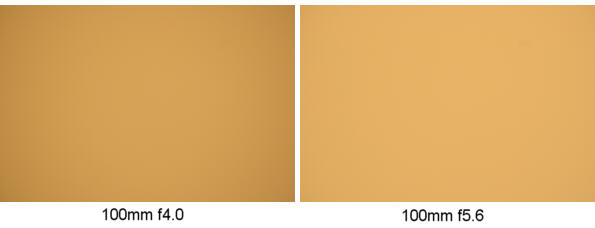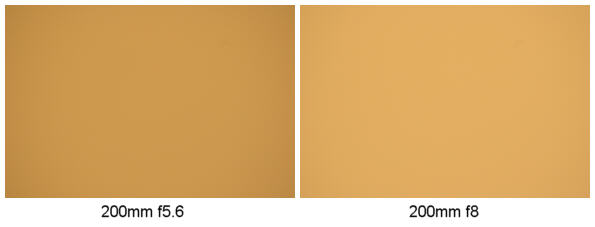Hemen Arayın : 0 542 4310154 Engin KARABULUT
Tamron AF 55-200mm f4-5.6 Macro LD Di II
Tamron 55-200/4-5.6 Di II LD
Part I
by Bob Atkins
Description
The Tamron AF 55-200mm Di-II LD Macro is a lens aimed at consumers who have bought a DSLR with an 18-55 kit lens, but now want something that covers longer focal lengths. For more on what Tamron have to say you can read the full text of the Tamron Press Release.
The Tamron AF 55-200mm Di-II LD Macro is pretty small and light, and has a semi-matte back finish. The body is plastic and the wide zoom ring has a rubberized grip. Manual focus is achieved by rotating a very narrow knurled ring (maybe 3mm wide) at the front of the lens. The manual focus ring is separate from the front of the lens. i.e. you don't manually focus by rotating the front of the lens as you do, for example, with the Canon EF-S 18-55/3/5-5.6. Manual focus operation is smooth, and though not heavily damped it doesn't have excessive free play. It's certainly feels better than, for example, the manual focus operation on the Canon EF-S 18-55/3.5-5.6. During focus (manual or auto) the lens barrel both extends and rotates. Zoom action is smooth and positive with no free play. There is no "zoom creep" when the lens is pointed vertically down, even if the lens is shaken.
Tamron AF 55-200mm Di II LD Macro specifications
| Model name | A15 |
| Focal length | 55-200mm |
| Maximum aperture | F/4-5.6 |
| Minimum aperture | f/32 |
| Angle of view | 28°28’ - 7°59’ (APS-C size equivalent) |
| Lens construction | 13 elements in 9 groups |
| Minimum focus distance | 37.4”/0.95m (Over the entire zoom range) |
| Maximum magnification ratio | 1:3.5 (at f=200mm, MFD 0.95m) |
| Filter diameter | 52mm |
| Overall length | 3.3 inches |
| Maximum diameter | 2.8 inches |
| Weight | 10.4oz. |
| Diaphragm blades | Nine blades |
| Standard accessory | Lens hood |
| Compatible mount | Canon AF, Konica Minolta AF-D and Nikon AF-D. |
The Tamron AF 55-200mm Di II LD Macro is designed for use on APS-C format DSLRs (i.e. DSLRs with 1.5x and 1.6x "focal length multipliers). It is not designed for use on full frame cameras, though it can be mounted on them as it has an EF compatible lens mount, not an EF-S mount (only Canon lenses have EF-S mounts). However, in fact the lens will "cover" a full 24x36mm frame as shown below:

Full frame shot using Tamron 55-200 on EOS 5D, 55mm f4
Note though that the corners are dark and close inspection shows the corners are quite soft and show evidence of increased chromatic aberration. So while you could use the lens on a full frame camera, unless you intend to crop it significantly (back to APS-C dimensions), it's not really a very good idea.
Overall, for a fairly low cost lens, the Tamron AF 55-200mm Di-II LD Macro gives a positive impression of construction quality, despite the fact that it's an all plastic lens including the lens mount (which Tamron say does have a metal "core"). It's obviously not up to Canon "L" series construction (or price...), but it doesn't feel "cheap and flimsy".
The lens come with front and rear caps (of course) and also includes a bayonet mounting lens hood (something Canon will charge you an extra $30 for on their consumer lenses).
The reported aperture when the Tamron AF 55-200mm Di-II LD Macro is mounted on an EOS 20D set to display aperture in 1/3 stop steps was as follows:
| Focal Length | Max. Aperture |
| 55 | f4.0 |
| 70 | f4.0 |
| 85 | f4.0 |
| 100 | f4.0 |
| 135 | f4.0 |
| 144 | f4.5 |
| 161 | f5.0 |
| 200 | f5.6 |
This seems a little unusual. I'd have expected a more gradual change in maximum aperture, however both the EOS 20D display and the image EXIF data confirm these numbers. I did note that while the exposure for a uniform target was the same at 55mm and 85mm, it increased by 1/3 stop at 135mm. The displayed aperture depends on data programmed into the lens, not an actual aperture measurement. I suspect maybe it's really closer to f4.5 at 135mm, but either way it's not terribly important.
Autofocus
I measured the time to shift focus from infinity to 37.4" (closest focus) to be almost exactly 1.0 seconds. Total time for focus from infinity to close focus and back to infinity (i.e. the cycle time if focus is not found) was 2.3 seconds, so there is a 0.3s lag time on turnaround. This isn't particularly fast. The 1 second is slightly slower than the 0.9s it took for the old Canon EF 75-300/4-5.6IS USM to go from infinity to close focus for example. The Canon EF 18-55/3.5-5.6 takes about 0.34 seconds to go from infinity to close focus and about 1.35 seconds for a full infinity - close - infinity cycle, but shorter focal length lenses don't have to move as far to shift focus, so you'd expect them to be a little faster.
Autofocus noise is average. There's an audible "whir" during focus but the noise isn't particularly obtrusive. It's of the same order as the focus noise of the EF 18-55/3.5-5.6, maybe just slightly louder.
Size
The Tamron AF 55-200mm Di II LD Macro is pretty small and light, only 3.3" long and 10.4oz (290g). It's slightly larger than the Canon EF 18-55/3/5-5.6 but it's only about 1/2 the size and weight of the EF 70-300/4-5.6 IS USM.

Left: EF 70-300/4-5.6 IS Center: Tamron 55-200/4-5.6 Right: EF-S 18-55/3.5-4.5
Vignetting
The Tamron AF 55-200mm Di II LD Macro shows some vignetting (darker corners) wide open, which generally pretty much disappears when the lens is stopped down by 1 stop. Here are some example shots of a uniformly illuminated target (the most severe test) shot using and EOS 20D body and aperture priority exposure. Vignetting would be much less obvious of "real world" shots.



It's noticeable that the wide open shots are a little darker than those taken stopped down by a stop. Vignetting wide open and slight underexposure is pretty common and a lot of lenses show it. For example below are similar shots from the Canon EF-S 18-55/3.5-5.6.

Finally here's a "real world" shot taken at 55mm and f4 with the Tamron AF 55-200mm Di II LD Macro. As you can see, the vignetting which shows up in the uniform target test above isn't really obvious in this shot..
